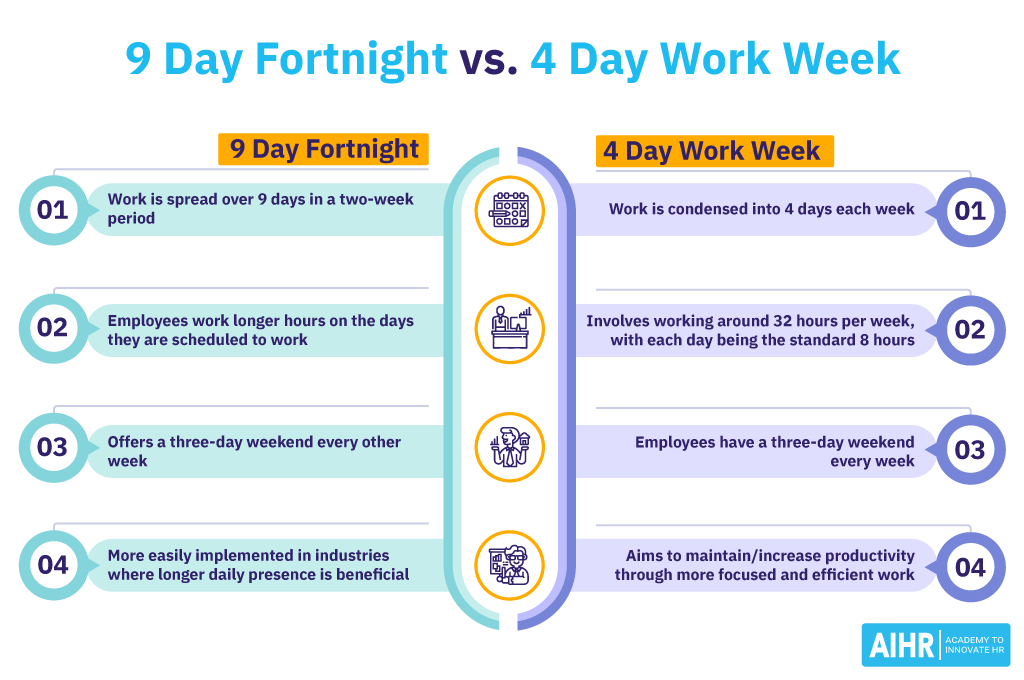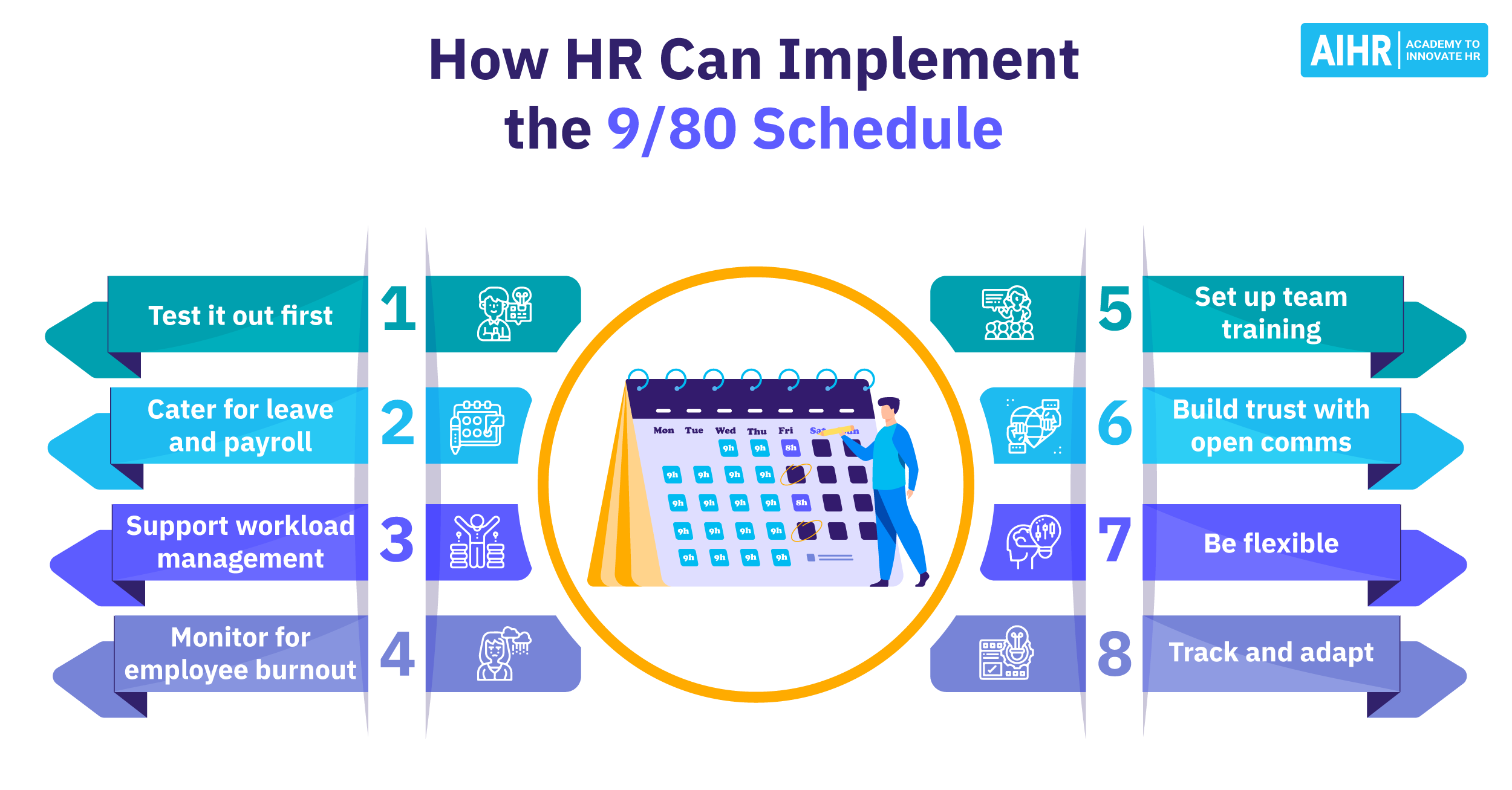9 Day Fortnight
What is a 9 day fortnight working pattern?
A 9 day fortnight is a flexible work arrangement where employees work a full-time schedule over nine days within a two-week period instead of the traditional 10 days.
This model allows for an extra day off every fortnight (two weeks), giving employees an extra day off without having to compromise on productivity or pay.
How a 9 day fortnight works
In a 9 day fortnight schedule, the total number of work hours remains consistent with a standard full-time schedule, but these hours are distributed over nine days instead of 10. Typically, this involves extending the workday slightly so employees can accumulate enough hours to take an additional day off every two weeks.
However, a 9 day fortnight can also be set up by simply reducing work hours without any drop in salary. Employees will keep their regular hours and get every other Friday (or another day of the week) off. This approach is less common but still boosts productivity in the same ways.
How do you calculate a 9 day fortnight?
Here’s how to calculate a 9 day fortnight, assuming a standard workweek of 40 hours.
- Total hours: First, determine the total number of hours an employee is supposed to work over the two-week period. For a standard 40-hour workweek, this would be 80 hours in two weeks.
- Daily hours: Then, divide the total hours by 9 days to find out how many hours the employee needs to work each day during the 9 day fortnight.
- Adjust schedule: The result will give you the number of hours the employee needs to work each day over the 9 days to maintain their full-time status and ensure all work hours are covered.
The formula
| Daily hours = | Total hours | |
| 9 | ||
For a standard 40-hour workweek, an employee would need to work approximately 8.89 hours, or 8 hours and 54 minutes each day over the 9 days of the fortnight, to meet their total required hours.
Use the 9-day fortnight calculator below to get an idea of the working hours that would be required:
9 day fortnight vs. 4 day work week: The differences
Work schedule
Employees work for nine days over a two-week period, usually taking every second Friday off.
Employees work for 4 days each week, typically having Fridays or Mondays off to get a long weekend.
Daily hours
Daily working hours are often extended to maintain full-time hours over nine days. For example, an eight-hour day might become a nine-hour day.
Daily hours remain the same, with total weekly work hours reduced to fit into four days.
Impact on pay
Typically does not affect pay as total hours worked remain the same.
May result in reduced pay unless the employer decides to maintain full-time pay for fewer working hours.
Cultural shift required
Necessitates minor adjustments as teams need to adapt to varying schedules bi-weekly.
The shift is more demanding since the entire organizational schedule must be compressed into fewer days.

Pros and cons of implementing a 9 day fortnight
Pros
- Better work-life balance: Employees can use the extra day off every two weeks to enjoy more personal time for family, hobbies, or rest, leading to better mental and physical health.
- Increased productivity: Some studies suggest that compressed work schedules can lead to increased productivity. Employees might work more efficiently to complete their tasks within the shortened work period, knowing they have an extended break coming up.
- Talent attraction and retention: Offering a 9-day fortnight can make an organization more attractive to potential employees who value flexibility and work-life balance.
- Environmental benefits: With one fewer day of commuting every two weeks, there’s a reduction in carbon emissions and traffic congestion. This not only benefits the environment but can also reduce transportation costs and stress for employees.
Cons
- Longer workdays: To fit the same number of weekly hours into nine days, employees need to work longer hours on those days, which could lead to burnout.
- Client and customer expectations: If the company needs to be operational five days a week, managing client expectations on days off could be challenging.
- Complex scheduling: Coordinating schedules for a team or between departments might become more complex and require more careful planning.
- Potential for inequality: If not implemented uniformly, some employees might end up with fewer days off or irregular schedules, leading to potential dissatisfaction.
9 day fortnight example
Here’s an example of how a 9 day fortnight working pattern could be implemented, assuming an employee typically works from Monday to Friday with weekends off, and aims to work a total of 80 hours over a two-week period:
| Week 1 | Week 2 |
| Monday: Work 8 hours 54 minutes | Monday: Work 8 hours 54 minutes |
| Tuesday: Work 8 hours 54 minutes | Tuesday: Work 8 hours 54 minutes |
| Wednesday: Work 8 hours 54 minutes | Wednesday: Work 8 hours 54 minutes |
| Thursday: Work 8 hours 54 minutes | Thursday: Work 8 hours 54 minutes |
| Friday: Work 8 hours 54 minutes | Friday: Off (this is the extra day off in the fortnight) |
How to implement a 9 day fortnight: Tips for HR
- Assess the suitability for your organization: Determine whether your business operations and employee roles are compatible with a compressed work schedule. Consider the potential impact on workload, client service, and whether tasks can be reorganized to fit the new schedule.
- Consult with stakeholders: Engage employees, managers, and unions in discussions to ensure the proposed schedule change is feasible and beneficial. Conducting surveys or meetings to gather input and address concerns can help gauge interest and identify potential challenges.
- Implement a trial period: Implement a pilot phase in select departments to help you identify potential hurdles and allow for adjustments before a full rollout. Collecting feedback to understand employee satisfaction and any impact on productivity.
- Develop a clear policy: Develop a comprehensive policy that details the implementation of the 9 day fortnight schedule. This should cover working hours, handling of overtime, and scheduling days off.
- Monitor and adjust: Establish performance metrics to evaluate the effect of the 9 day fortnight. This ongoing assessment will guide necessary adjustments to optimize the schedule.
HR tip
Switching to a 9 day fortnight working pattern can boost employee wellbeing, spike productivity, and improve work-life balance. It also makes your company more attractive to top talent by showing you value their time and life outside of work.
FAQ
A 9-day fortnight shift pattern involves working your usual weekly hours over nine days instead of 10. This typically means you work longer days to earn an extra day off every two weeks.
Yes, a 9 day fortnight arrangement maintains full-time working hours by adjusting daily work hours to spread the standard full-time hours over nine days instead of 10.
Annual leave accrual in a 9 day fortnight arrangement typically remains the same as in traditional work schedules, based on the total hours worked.
Working a 9 day fortnight can be worth it if you value having an extra day off every two weeks. It offers a better work-life balance, but you’ll need to manage slightly longer workdays to make up the hours.









